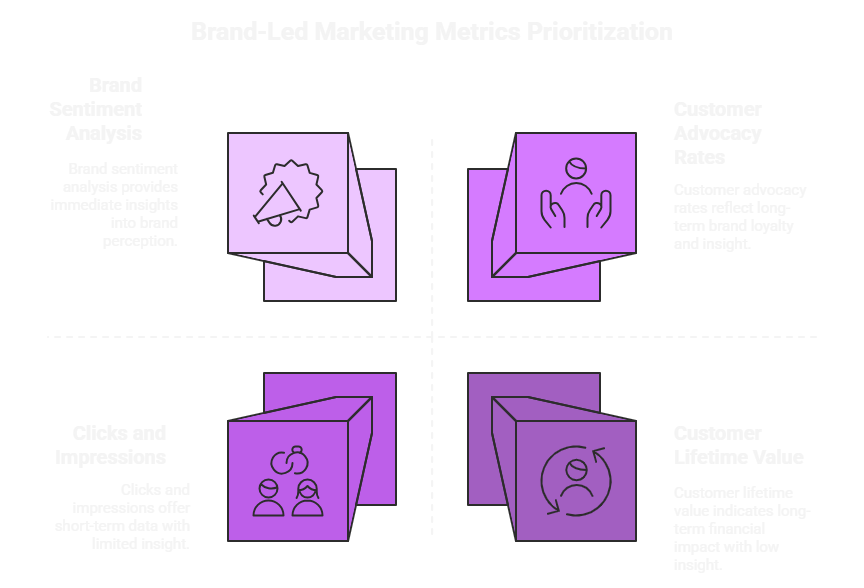Brand-Led Marketing & Visual Storytelling That Connects

Do you remember when brands shouted product features at us with every billboard and TV advertisement? It was like the Stone Age, something you can relate to the outdated flip phones. Millennial and Gen Z consumers, particularly the digitally native ones, are no longer interested in selling a product but want to purchase a narrative, ideology, and genuine experiences. The age of brand-led marketing has come, and your brand's personality counts more than your product's price.
When you continue to focus on features rather than feelings, you go to dinner, and all you talk about is what is being served at the dinner table. And I can promise you that no one wants to be that person.
The Evolution Product-Push to Purpose-driven Branding
The marketing environment has changed in essence. We have taken a step back from the old advertising method, spray and pray, to what is much more advanced, the purpose-led branding that appeals to the hearts and heads of the consumers. Brand-led marketing is not just the in-vogue word of the day, but it is a business exigency that involves placing your brand as the focus point of all marketing decisions.
Now consider this:
The last time you bought a product based on its specifications? You are more likely to have picked it due to how the brand made you feel, what it represented, and how it did or did not fit your values. This is the effectiveness of story-based marketing.
Apple is one trailblazer in storytelling as a way of branding. They sell not only their phones; they sell creativity, innovation, and the idea to think differently. Their visual narrative makes all their product releases a cultural event and makes the customers feel they belong to something bigger than buying the product.
How is brand-led marketing different?
Conventional marketing questions include: How will we sell more products? The question that brand-led marketing poses is, how can relationships be deepened? The switch in focus will alter everything, including your message and visual content marketing strategies.
Brand-led marketing focuses more on developing an emotional connection than promoting product attributes. It is about a standardized brand image that will strike harmony at all contact points and instil brand loyalty using storytelling, not mere promotional strategies.
This strategy also considers that the current generation of consumers, particularly those looking to experience a genuine brand message, are ready to spend more on brands that support their values.
The statistics do not deny it; the pace of growth in revenue in companies with strong brand identity marketing is 23 percent more than the companies with little brand identity. Also, two-thirds of consumers claim that they would be willing to pay more when buying a product with a brand name that is considered sustainable and socially conscious by consumers.
Visual Storytelling: The Insider Tool of Modern Branding

This is when the action starts. Whereas brand-led marketing establishes the strategic base, visual storytelling brings your brand to action. Visual information is 60,000 times faster to process than text content, meaning that visual content marketing is not nice but a must-have when overcoming information overload on the Internet today.
Visual storytelling covers everything from video storytelling in your marketing campaigns to the design of your brand's identity. It is all about the ability to design a visual language sensibility that tells your brand values without word of mouth. Consider Nike swoosh; that subtle design triggers feelings of sports success, driving ambitions and empowerment.
To be a good visual storyteller, it does not suffice to have pretty pictures. It requires tactical planning that considers the usefulness of each visual recipe in the overall brand marketing plan. The colour scheme, font type, visual styles, and even the space you use must support your brand identity and values.
Best Practices of Brand Storytelling in Real Life
We can look at some of the brightest examples of brand storytelling efforts that illustrate the strength of positioning the brand at the centre of marketing and applying strong visual storytelling.
John Lewis has conquered emotional branding through their annual Christmas campaigns. Their Give a Little Love campaign marketed products and shared the story of human connection, acts of kindness and community. The campaign earned millions of impressions and substantially increased brand sentiment, demonstrating that a genuine message can reach beyond the standard sales measurement.
This has resulted in strong brand loyalty among environmentally conscious customers in a rather brutal way.
Patagonia is another step ahead in the direction of storytelling methods of marketing goods to the people by putting it as the focus of their brand activism. Their Don't Buy This Jacket campaign ironically boosted sales by proving their seriousness on the issue of the environment. They have a pattern of using actual outdoors people, environmental activists, and conservation activity in their visuals with a clear message that authentic messages need no refinishing to become effective.
The Psychology Behind Emotional Connection in Marketing
To comprehend why brand-led marketing sells, one needs to get into the psychology of consumers. The behaviour of modern purchasers who specifically target Gen-Z and Millennial consumers by branding them is to initially form emotional associations with the purchase and justify the decision later using rational appeal.
This generation was brought up to have unlimited choices and very advanced marketing rhetoric. They have grown accustomed to what marketers call banner blindness, or the capability to ignore conventional advertising. What wins through this sieve? Real-life-based stories resonate with their beliefs and lives.
Here, brand consistency in marketing is vital. Maintaining the same message and visual identity in all the contact points, including social media platforms and visitor visits, ops recognition, and trust in the mind audience's mind cohesiveness make psychologists say that you reach a level of so-called fluency: people associate your brand with something familiar and trustworthy, even if they are new customers.
Building Your Visual Storytelling Strategy

The important parts of developing a good visual story include planning and effective execution. Begin with the foundational story of your brand: What have you got to say? Which feelings do you change to provoke? What do your values convert into visual elements?
Your user-generated content strategy should enhance the genuine stories of customers instead of overwriting them with a corporate message whose language is already clean. Brand trusting campaigns commonly involve other real customers speaking on their real brand experiences. This presents the social proof and evidence that your brand values are marketing words and customer experiences.
Using infographics in online marketing has two purposes: it helps to organize complicated data and support your brand's visual identity. Properly designed infographics show your brand proficiency and uniformity of design across mediums.
Video marketing has played a very instrumental role in establishing an emotional connection. There is no difference between behind-the-scenes videos, customer testimonials, and brand mission videos, as they can be richly told through visual imagery, sound, and narrative.
The Technology Behind Modern Brand Storytelling
The current digital context is creating various possibilities for advanced brand storytelling. Using social channels, content management systems, and social analytics allows brands to establish, place, and quantify the effects of storytelling in the most detailed manner.
Technology, however, must augment your story, not act as a substitute for it. The most effective marketing campaigns led by brands apply technology to elevate real-life stories instead of making them up. This can include data analytics, knowing which stories your audience connects with the most, or using social media tools, where you can have genuine conversations about your brand values.
The trick is human integrity, along with technological possibilities. Even when using digital media, your storytelling strategies to marketers must sound like an intimate and truthful message.
Measuring Success in Brand-Led Marketing
Conventional marketing metrics, such as clicks, impressions, and immediate conversion, can only take a share of the pie in brand-led marketing. Though the metrics are important, they would not present an entire picture of what emotional branding and long-term brand building can convey.
More useful ones are brand sentiment analysis, customer lifetime value, brand recall and recognition, quality of social media engagement (not 10 percent is enough, tweet), and customer advocacy rates. These metrics are useful for providing greater insight regarding creating authentic connections and developing business value in the long term via your brand storytelling.

Here, a possible metric is to monitor the effect of your brand messaging on customer behaviour over time. In case of availability of alternatives, do customers prefer your products? If they do, do they share about your brand with other people? Are they ready to pay high prices? These signs demonstrate the real strength of efficient brand-based marketing.
The Future of Brand-Led Marketing
A few trends define the future of brand-guided marketing and visual storytelling. The industrialization of personalization is gaining more sophistication so that brands can connect with their consumers more and more and still make that fit within the framework of consistency brought across the brand. New possibilities are rising through an immersive brand experience through augmented and virtual reality.
Social corporateness and sustainability are getting into the non-negotiable list of brand identity, especially among younger consumers. Any brand that does not demonstrate actual efforts to live up to these values will become obsolete in a market always vibing with consciousness.
A shift in the use of voice commerce and smart devices is also altering how brands inform their story. Audio and conversational interfaces need to be considered when telling visual stories, and this has opened up another challenge and opportunity for innovative marketers.
Conclusion: The Brands That Will Succeed
Your brand is the future. You need to realize that people do not buy products. People buy stories, values, and connections. Emotional personal relationships with customers are based on brand-led marketing supported by striking visual stories about a given destination, organization, company, or business.
Those brands that will excel in the 2020s are the ones that have learned to consistently share genuine stories at all touch points with a level of consistency. They will no longer rely on visual content to present the products; they will allow customers to enter authentic stories that share the same values and dreams.
When you create your brand marketing strategy, remember that every piece of content, every visual you use, and every exposure to your customers will be a chance to strengthen your brand narrative. It is not even the question of whether you are telling a story--you are always telling a story. One thing to ask: are you telling the right story as consistently as possible and as your true self in a manner that results in real relationships with those personalities to whom your business is ultimately most relevant?
In a world where people have more choices, less time, and shorter attention spans, there is only one thing left to fight over: the brands that go beyond selling products; they create movements, communities, and stories that people want to share. Well, not only smart marketing -- but also the basics of developing brands that are more than just connective.



